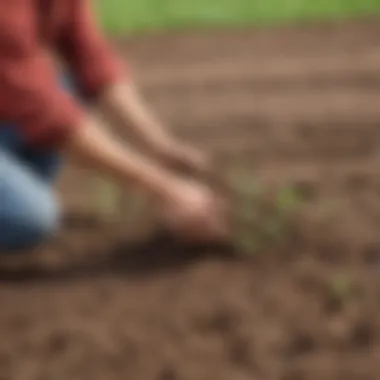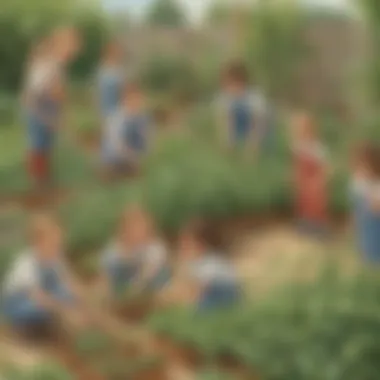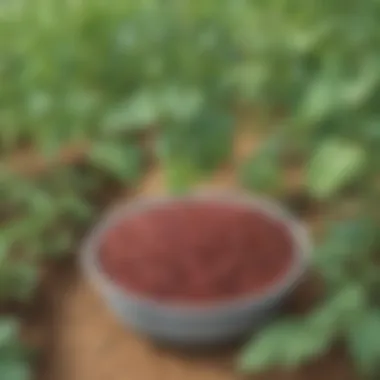An In-Depth Guide to Growing Beans for Enthusiasts


Intro
Growing beans is more than just a gardening endeavor; it represents a holistic approach to fostering sustainability and nutrition. Beans belong to a diverse group of plants, prized not only for their contributions to meals but also for their central role in enriching soil through nitrogen fixation. This shallow dive aims to unpack the profound insights into cultivating beans, meeting their unique demands, and effectively reaping the benefits they offer.
Cultivating beans provides excellent teaching moments for children, instilling values related to nature, agriculture, and health. Additionally, the selection of various types of beans can suit different gardening conditions, thus yielding different flavors, textures, and uses in the kitchen. Parents, teachers, and guardians seeking to involve children in these activities will find a thoughtful approach conducive to play-based learning. In doing so, individuals can develop a genuine appreciation for sustainable agriculture.
Effective cultivation requires understanding the fundamentals such as bean variety, environmental needs, and best care practices. However, through various engaging activities presented here, readers will learn not just how to grow beans, but how to intertwine these experiences with enjoyment and education.
Bean cultivation today encompasses responsibilities that extend beyond gardening. Therefore, to develop a well-rounded understanding of putting these insights into practice, let’s delve into some fun activities.
Fun Activities Ideas
Getting children involved in bean growing can be wonderful and rewarding. It cultivates skills beyond gardening and nurtures curiosity. Several fun activities are designed to make the process interactive and enjoyable.
Indoor Activities
- Bean Journals: Encourage kids to maintain a journal of the growth progress of their beans, including drawing or photographing changes as they develop.
- Bean Crafts: Using dried beans, create fun art projects like bean mosaics. This helps enhance creativity while familiarizing them with different bean types.
- Thematic Story Time: Select books focused on gardening and beans for rich storytelling sessions, capturing kids' imagination against the backdrop of agriculture.
Outdoor Adventures
- Garden Setup: Start by involving children in preparing the garden bed. It expands their perception of what goes into successful bean cultivation.
- Seed Planting: Have kids plant seeds. Let them dig small holes, which adds an element of hands-on learning as they familiarize themselves with planting techniques.
Arts and Crafts
Using beans, children can produce decorative items. Simple activities like making necklaces or decor out of string and beans can create lasting familial bonds through shared projects.
Science Experiments
- Germination Tests: Perform experiments comparing bean germination in different conditions. This could illustrate environmental sustainability and science simultaneously.
- Plant Growth Observations: Kids can measure their beans’ height growth weekly, transforming these simple observations into basic graphing lessons.
Cooking and Baking
Selecting easy recipes including beans can illuminate culinary skills as well as the nutritional benefits of these powerful legumes. Recipes such as bean soup or bean salads can serve as a vehicle for discussion about nutrition.
It is critical to emphasize fun, tangible learning interactions when introducing gardening to young minds.
Getting children actively involved in growing beans not only promotes life skills but underscores responsibility and yielding to patience as they see their results bloom right before their eyes.
Prelude to Bean Cultivation
Bean cultivation is a significant aspect of gardening that combines practicality with education, making it vital for both seasoned enthusiasts and new gardeners. Beans are not just versatile in the kitchen; they are crucial to sustainable agriculture, making them a key element in the food system. Growing beans teaches useful gardening skills, which can be especially advantageous for children and beginners. This guide aims to unravel the essential facets of cultivating beans, emphasizing their ecological value and practical benefits.
Importance of Beans
Beans play a pivotal role in nutrition and sustainable practices. They are rich in protein, fiber, vitamins, and minerals, making them a valuable food source for various diets. The diverse forms of beans, including kidney and black beans, contribute essential nutrients while being cost-effective to grow and prepare. From a cultivation standpoint, beans improve soil quality through a process called nitrogen fixation. They enhance soil health and provide essential nutrients for subsequent crops. This symbiotic relationship between plants is fundamental in agriculture.
In addition to their nutritional journey from farm to table, beans represent a perfect gateway for educational excursions in gardening. For children, witnessing the seed's growth into a harvestable legume diminishes the gap between awareness of where food comes from and daily eating habits.
Overview of Bean Varieties
The world of beans encompasses a diverse array of varieties, each with distinct characters and uses. Understanding these differences is essential for anyone considering incorporating beans into their home garden. Broadly speaking, bean varieties can be classified into two main categories: dry beans and snap beans.
Dry Beans: These beans are harvested when mature and dried, allowing for long-term storage. Kidney beans and black beans fall under this category. They are excellent for bean salads, stews, and protein-packed dishes.
Snap Beans: These are picked while immature, known for their tender texture and often eaten raw or lightly cooked. Varieties such as green beans fit into this category. They are popular in various cuisines and appreciated for their harvesting flexibility.
Among these, specific varieties may be more suited to particular climates, making bean selection an important aspect in cultivation. The requirements for each variety can vary; exposure to factors like sunlight and moisture plays a critical role in successful growth. As we delve further into this guide, consider these varied aspects to tailor your cultivation practices effectively.


Choosing the Right Beans
Choosing the right beans is an essential step in successful cultivation. Each type of bean has its specific requirements and characteristics. Therefore, understanding these factors allows you to select the most suitable beans for your garden. This knowledge not only enhances your gardening experience but also increases the chances of a fruitful harvest. Moreover, choosing wisely can lead to growing beans that are either nutritious or better suited to your climate, thus contributing positively towards sustainability.
Common Types of Beans
Kidney Beans
Kidney beans are very popular among gardeners. They have a firm texture and mildly flavored beans. This makes them an excellent selection for dishes like chili and salads. One main characteristic of kidney beans is their high protein content, combined with dietary fiber. Their unique feature is their shape, which resembles a kidney; thus, the name. On the advantage side, they can be grown in a varied climate. However, one must ensure they are not over-watered as this might lead to rot.
Black Beans
Another commonly chosen type is black beans. They possess a slightly sweet flavor, which makes them highly versatile in kitchen uses, especially in soups and tacos. Black beans are rich in antioxidants that can support overall health, making them a beneficial choice in any garden. Their unique dark color also distinguishes them from others. As for disadvantages, they require warm temperatures for optimal growth, and thus may not be suited for colder climates.
Green Beans
Green beans are perhaps the easiest type to cultivate. They grow well in most Garden settings and are quick to yield results, which adds to their appeal for new gardeners. Green beans are appreciated for being fresh and crunchy. Their growth habit allows them to take up less space compared to other varieties, especially if you opt for pole varieties. However, they require consistent attention to avoid pests which can be a drawback for some.
Lima Beans
Lima beans are valued for their buttery flavor and creamy texture. They are often used in cooking and add great nutritional benefits. Importantly, they enrich the soil with their nitrogen-fixing capability, contributing positively to sustainable farming practices. One attraction of lima beans is their ability to thrive in warmer climates. Conversely, they can be less hardy in cooler temperatures, which may present limitations in certain regions.
Factors in Bean Selection
Climate Considerations
Climate is a significant factor in bean selection. Each bean variety thrives in certain weather conditions. Understanding local climate can guide gardeners in their decisions. For instance, beans are generally warm-season crops, making them unsuitable for frost-prone areas. This prioritizing makes it possible for enthusiasts to choose species that will guarantee maximum growth potential. Remember, knowing appropriate planting and harvest times is crucial to successful management.
Space and Growth Habit
The growth habit of beans can influence garden planning significantly. Some beans grow as bush types, while others are vine types and require trellis supports. Assessing the space available is essential. Choosing space-friendly beans allows for optimizing garden layout. The advantage here is maximizing productivity within a limited space. Vegetable gardening can add challenges, but beans often offer more rewards than complications.
Soil Preparation for Beans
Soil preparation serves as a fundamental cornerstone in the thriving cultivation of beans. Discerning gardeners recognize the worth of investing time and resources into establishing optimal soil conditions. The right soil not only fosters healthy growth but also maximizes yields and fruit quality. Attention must be devoted to specifics such as soil type, drainage capabilities, and nutrient content. Moreover, understanding the dynamics of soil health influences the longevity of successful gardening endeavors.
Soil Type Requirements
When selecting the appropriate soil for bean cultivation, several attributes of soil types must be deliberated. Beans generally prefer well-draining, loamy soil with a pH level ranging from 6.0 to 7.5. Sandy loam offers the balance—adequate drainage paired with enough organic matter to retain moisture. Heavy clay soils can hinder root growth due to poor aeration and excessive water retention. This can often lead to root rot.
To amend soil types that lack compatibility, soil testing is advocated. Benefits of soil testing include the identification of nutrient deficiencies and pH levels. Amending the soil with organic matter like compost, vermicompost, or well-rotted manure can create the necessary conditions for stable bean growth.
Key Tips for Soil Type:
- Aim for loamy quality, combining sand, silt, and clay adequately.
- Test pH levels and aim for adjustably neutral.
- Improve clay soils with coarse materials to enhance texture.
Nutrient Management
Nutrition significantly impacts the health and productivity of bean plants. Soybean responsiveness to nutrients combines acknowledgement of existing soil qualitative measures and dynamic amendments. Typically, beans perform well in nutrient-rich soil that has balanced levels of nitrogen, phosphorus, and potassium.
Interestingly, beans fix atmospheric nitrogen due to a symbiotic relationship with Rhizobium bacteria. Therefore, they do not necessarily need high nitrogen input. Nevertheless, adding phosphorus and potassium remains vital as these nutrients spearhead root growth and flowering.
A soil test provides insights into existing nutrients and suggests practices for amendments. Incorporating well-composted organic matter is a beneficial practice, fostering biological activity in soil and improving nutrient cycling.
Essential Components for Nutrient Management:
- Monitor nutrient levels through soil testing methods.
- Incorporate complementary fertilizers as per soil test results.
- Utilize mulch to conserve moisture, reduce weeds, and contribute organic matter over time.


In summary, suitable soil preparation sets the stage for productive bean cultivation by creating ideal growth conditions and ensuring consistent nutrient availability.
Planting Beans
Planting beans is a vital stage in the journey of growing this versatile crop. Selecting the right time and applying appropriate planting techniques can greatly influence bean yield and health. The decisions made during this phase determine not only the speed of germination but also the overall growth of the plants. Proper planting practices ensure that the micro environment required for beans is established, setting the stage for an abundant harvest.
Timing and Weather Conditions
Timing is crucial when planting beans. Ideally, beans should be planted when the risk of frost is minimal and the soil temperature has stabilized. Generally, this occurs after the last frost date in spring when the soil reaches at least 60°F. Planting too early can lead to poor germination and slow growth since cold soil hampers seed development. Conversely, keeping an eye on excessive heat during the summer months is also necessary; mature plants can suffer if exposed to harsh sun without adequate moisture.
Some farmers take note of seasonal patterns by observing night temperatures and rainy periods. These can serve as excellent indicators of when to plant. For instance, a consistent evening temperature of above 50°F is a good sign that beans can be sown. Checking local climate reports can provide guidance based on regional characteristics.
Remember: Soil moisture is also essential. Beans appreciate good drainage. A water-loggged soil, particularly during the early weeks of growth, will negatively affect seed sprouting.
Planting Techniques
When it comes to planting techniques, several strategies may be employed based on available space and resources.
- Row Planting: This standard method involves sowing seeds in rows spaced about 12 inches apart. It's efficient for maintenance and allows for easy access to the plants.
- Hills Planting: Seeds are sown in small groups, or
Caring for Bean Plants
Caring for bean plants is crucial for the health and productivity of your garden. Beans are often resilient, but without proper care, their growth can be inhibited, leading to poor yields. Hence, the importance of this section cannot be understated. By grasping the fundamental aspects of watering, weeding, and pest management, you can create an environment that encourages robust growth. This section will cover two primary elements: watering regimen and weed and pest management.
Watering Regimen
The right amount of water significantly affects the growth of bean plants. Beans require consistent moister in their soil. However, over-watering can lead to root rot and other complications. Here are key considerations for managing the watering process:
- Frequency: Water your bean plants at least once a week. If the weather is hot, increase the frequency. Beans usually prefer the soil to be moist but not soggy.
- Soil Checking: Check the soil moisture by digging a bit into the soil near the root system. If it feels dry an inch or two beneath the surface, it is time to water.
- Early Morning Watering: Watering early in the day helps to minimize evaporation. It also allows plants to absorb moisture before the heat rises.
An effective watering regimen encourages strong root development, leading to healthier plants overall. This simple care method often determines the productivity of the crop.
Weed and Pest Management
Weeds and pests are common challenges when it comes to growing bean plants. Neglecting weed control can lead to competition for nutrients and water. Effective pest management, on the other hand, prevents further plant damage. Here are steps to ensure successful management of both:
- Manual Weeding: Regularly check your bean plants for weeds and remove them by hand or with a hoe. Regular weeding helps maintain optimal growth conditions.
- Mulching: Covering the ground around your plants with mulch can help suppress weed growth. Organic mulches also improve soil health as they decompose.
- Natural Pest Control: Introduce beneficial insects like ladybugs that prey on aphids and other pests. Additionally, regularly inspect leaves and stems for signs of insect damage or infestation. If needed, natural insecticides can be utilized as uch.
Controlling weeds and pests not only protects your bean plants but also fosters a healthier growing environment.
In summary, diligent care in supervising water needs, coupled with focused weed and pest management, fosters thriving bean plants. Remember, every insect, droplet, and weed plays a significant role in the health of your garden. By being proactive, you can reap the rewards of a bountiful bean harvest every season.
Harvesting and Storing Beans
Harvesting and storing beans is a crucial final step in the cultivation process. Understanding when and how to harvest beans ensures that the plants reach their ideal maturity, thus maximizing flavor and nutritional value. Proper storage methods further maintain these qualities, so they remain ready for consumption or planting. In this section, we will cover how to identify the right time to harvest, appropriate methods for harvesting beans, and effective ways to store them to preserve freshness and taste.
Identifying Harvest Time
The time to harvest beans varies depending on the type grown. Typically, beans are ready to be harmed when the pod turns brown or when is firm to touch. There are key factors to consider in this process:
- Pod Color: Look for shade shifts in the pods. For many dry bean varieties, a beige or brown tint signifies readiness.
- Texture: While some beans are good when tender and still green, others should be harvested only when fully mature which renders the inside crunchy. Knowledge of specific varietals is essential.
- Seed Firmness: If you can break a seed easily, it’s likely not ripe yet. Mature seeds should be firm and resistant to pressure.
Beans left too long can split or decay on the plant. Careful observation is necessary to catch the optimal moment.
Involving children in observing these changes could enhance their awareness of nature, while solidifying observational skills.
Methods of Harvesting


Harvesting can be conducted quite simply once you identify the right time. Below are strategies that ensure a successful harvest:
- Hand Harvesting: Ideal for small gardens, one can carefully pick the mature pods while avoiding unripe ones. This method allows for better examination of the plant.
- Use of Tools: For larger agricultural settings, tools like pruning shears or scissors can speed up the harvesting process. Make sure to clip the stems to avoid damaging the plant, which could impede future growth.
- Whole Plant Harvesting: Pulling up entire plants may be preferable for beans like sugar snap peas, where you want the full pod. This should be done at higher temperatures to ensure the beans do not freeze post-harvest, if you grow in notoriously cold climate.
Also, consider the possibility of sharing the harvesting fun with kids. It provides an engaging way to teach them about plant growth and responsibility.
Storage Solutions
After harvest, proper storage techniques ensure beans retain optimal quality. Here are advised practices:
- Drying: Ensures that beans reach the correct dryness before storage. Lay them out in a single layer in a shady area or use a dehydrator for uniformly dry beans.
- Containers: Storing dried beans in airtight containers, like glass jars, prevents spoilage and rodents. Label periods for easier tracking.
- Freezing: Beans that are after-harvest still fresh can be placed in freezer-safe bags. On thawing, beans may lose some texture but retain taste suitable for warming dishes like soups.
- Consider using clear containers to monitor contents without opening them regularly.
- Place beans in a cool, dark place to slow down deterioration.
These storage solutions provide opportunities for children to learn simple preservation techniques while cooking delightfully nutritious meals down the line. Involvement in this stage solidifies full cycle awareness in gardening, showing also the value of grown food.
Educational Aspects of Growing Beans
Beans offer a unique opportunity for education in numerous ways. Growing beans is not only beneficial for hands-on gardening experiences but also for developing critical life skills. When you involve children in the process of growing beans, you embrace a multifaceted approach to learning. Engagement with nature, science, mathematics, and nutrition can all be achieved through this simple act.
Firstly, planting and nurturing beans helps to cultivate responsibility and patience. Children learn the significance of caring for living organisms, as aggravated growth can depend directly on the amount of effort they put into the plants. Over time, kids gain a deeper understanding of the life cycle of the plant from seed to harvest. This represents a fundamental concept in biology that connects children to their living environment.
Moreover, beans thrive in variable climates and conditions. Learners can experiment with various factors that affect growth, such as light, moisture, and soil composition. This hands-on inquiry encourages curiosity and critical thinking skills as they observe and document their findings. Gardening becomes a live observational experiment; they gain firsthand insights about ecosystems and sustainability as well.
Finally, involving children in the process of planting, watching, and eventually harvesting creates connections that last a lifetime. The simple act of muddy hands in soil evolves into scenic memories, instilling pride and accomplishment when they eventually prepare a meal with their harvested beans. This journey journey promotes nutrition indirectly by highlighting the connection between growing food and understanding healthy eating.
Learning Opportunities in Gardening
Gardening offers abundant learning opportunities beyond just science. By growing beans, children experience ybildungs unique chances for observations, hands-on activities, and numerous learning applications. Here are key areas where students can expand their knowledge:
- Science: Understanding plant biology, ecosystem interactions, and variations in growth.
- Mathematics: Measuring growth, calculating areas for planting, or tracking yield.
- Art and Creativity: Designing garden layouts, planting patterns, and even detailed growth journals.
- Social Skills: Working in teams during group gardening projects enhances communication and collaboration.
Encouraging student involvement in these areas promotes a well-rounded educational experience. Schools can turn a mere plot of land into a vibrant classroom.
Involvement of Children in Gardening
Engaging children in gardening strengthens their connection to nature and enhances various skill sets. It allows young people àto ecosystem perceptions, explore ethical and horizontal connections in the food supply chain, and foster empathy towards living things.
- Mentorship Opportunities: By pairing seasoned gardeners with novices, knowledge transmission becomes meaningful for both parties. Adults impart wisdom, and children apply their imaginative ideas for practical situations.
- Community Involvement: Participating in local garden initiatives can enhance relationships. Children develop a sense of belonging in their community while experiencing firsthand the benefits of shared labor.
- Healthy Body Image: Working outdoors assists children in being aware of physical health and balanced diets, which in turn channelize a positive, confident self-image.
Outdoor experiences draw children away from screen time, allowing them to embrace uncertainty and embrace real challenges as they grow.
In summary, gardening with beans serves as an enriching educational endeavor leaving lasting impacts on the minds that nurture them. From biology to nutrition, every step in the process is another lesson waiting to unfold.
End
The conclusion section serves as a pivotal moment in the discussion of growing beans. It encapsulates the foundational aspects that have been explored, reinforcing the significance of bean cultivation in both home gardens and educational settings.
Recap of Key Points
In this article, we have discussed various crucial elements related to bean growth:
- Importance of Beans: Beans are a vital source of nutrition and sustainability. Their ability to enrich soil and provide protein makes them a staple in many diets.
- Variety of Beans: Understanding the different types of beans, like kidney, black, and lima beans, helps in selecting the right type for specific environments and conditions.
- Soil and Plant Care: Emphasis was placed on soil preparation, nutrient management, and effective watering practices that optimize bean growth.
- Educational Aspects: The engagement of children in gardening activities fosters responsibility, patience, and a respect for nature. It's an opportunity to blend learning with practical experience.
These dimensions collectively underscore the fulfilling experience of growing beans.
Encouragement for Bean Cultivation
Engaging in bean cultivation should not just be considered a hobby; it is a gateway to developing vital skills in children and an enriching experience for families. The act of planting, caring for, and ultimately harvesting beans builds a strong bond with nature and instills a sense of achievement.
Experience the joy of watching seeds transform into resilient plants. It brings families together and creates moments worth remembering. I urge you to start your journey by planting simply one kind of bean this season. Nurture it and witness the magic of nature. Make it a learning experience for kids; the lessons harvested here exceed merely growing plants.
When families cultivate beans, they contribute to sustainability. They support local ecosystems and experiences that transcend generations. This is not just gardening; it’s a commitment to nourishing the planet and its people.



